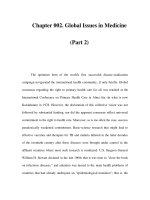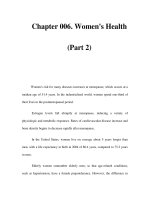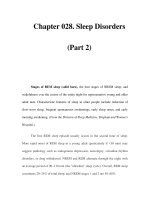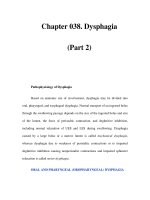Chapter 056. Cutaneous Drug Reactions (Part 2) pps
Bạn đang xem bản rút gọn của tài liệu. Xem và tải ngay bản đầy đủ của tài liệu tại đây (35.9 KB, 5 trang )
Chapter 056. Cutaneous
Drug Reactions
(Part 2)
PATHOGENESIS OF DRUG REACTIONS
Untoward cutaneous responses to drugs can arise as a result of
immunologic or nonimmunologic mechanisms. A variety of adverse reactions
result from mechanisms that do not involve an immunologic process. Drug
reactions are a public health problem because of their frequent occurrence,
occasional severity, and impact on the use of medications. The skin is among the
organs most often affected by adverse drug reactions. The list of conditions that
can be triggered by medications includes nearly all dermatologic diseases. Many
of these adverse reactions result from mechanisms that do not involve an
immunologic process. Obvious examples are pigmentary changes related to
accumulation in the dermis of amiodarone, antimalarials, minocycline, quinolones,
alteration of hair follicules by cytostatics, and lipodystrophy associated with
metabolic effects of anti-HIV medications. These side effects are mostly toxic,
predictable, and often can be avoided at least in part by simple preventive
measures.
Immunologic Drug Reactions
For most acute drug eruptions, benign or severe, accumulated data suggest
an immunologic basis. In the last 10 years drug-specific T cell clones were derived
from the blood lymphocytes or from skin lesions of patients with a variety of drug
allergies. Since these clones had been obtained after several stimulations in vitro
with the drug, their relevance to explain the original manifestations of allergy can
be questioned. Regardless, these T cell clones brought definite evidence that drugs
can be recognized as antigens by human T cells, and that these T cells play a role
in drug allergy. Specific clones were obtained with penicillin G, amoxicillin,
cephalosporins, sulfamethoxazole, phenobarbital, carbamazepine, lamotrigine, i.e.,
many of the medications that are frequently a cause of drug eruptions. Both CD4
and CD8 clones were often obtained, whatever the clinical type of eruption.
Some clones produced a T
H
0 profile of cytokines (simultaneous release of
IL-4 and IFN-γ). A T
H
2 orientation was frequent in CD4+ clones while CD8+
clones were usually T
H
1 and often cytotoxic. Drug presentation to T cell was
MHC-restricted, usually as expected by HLA class II for CD4+ cells and by HLA
class I for CD8. But there were also less classic situations like HLA class II
restricted cytotoxic CD4 clones. With many drugs, an original observation was
that the drug could be presented to the TCR and activate a specific clone without
prior processing by the antigen-presenting cell and through a noncovalent binding
to the MHC or its embedded peptide. Actually, some specific TCR could
recognize sulfamethoxazole presented either in covalent or noncovalent bound
form, but the former was the exception and the latter the rule. Since the
noncovalent binding is reminiscent of the pharmacologic interaction between a
drug and its receptor, the denomination of pharmoco-immune (p-i) concept has
been proposed.
Once a drug has induced an immune response, the final phenotype of the
reaction probably depends on the nature of effectors: cytotoxic (CD8+) T cells in
blistering reactions, chemokines for reactions mediated by neutrophils or
eosinophils, and collaboration with B cells for production of specific antibodies
for urticarial reactions.
IMMEDIATE REACTIONS
Immediate reactions depend on the release of mediators of inflammation by
tissue mast cells or circulating basophilic leukocytes. These mediators include
histamine, leukotrienes, prostaglandins, platelet-activating factor, enzymes, and
proteoglycans. Drugs can trigger mediator release either directly ("anaphylactoid"
reaction) or through IgE-specific antibodies. These reactions are usually manifest
in the skin and gastrointestinal, respiratory, and cardiovascular systems (Chap.
311). Primary symptoms and signs include pruritus, urticaria, nausea, vomiting,
cramps, bronchospasm, and laryngeal edema—and, occasionally, anaphylactic
shock with hypotension and death. They occur within minutes of drug exposure.
Nonsteroidal anti-inflammatory drugs (NSAIDs), including aspirin, and
radiocontrast media are frequent causes of pharmacologically mediated
anaphylactoid reactions, which can occur on first exposure. Penicillins and
myorelaxants used in general anesthesia are the most frequent causes of IgE-
dependent reactions to drugs, which require prior sensitization. Release of
mediators is triggered when polyvalent drug protein conjugates cross-link IgE
molecules fixed to sensitized cells. Certain routes of administration favor different
clinical patterns (e.g., gastrointestinal effects from oral route, circulatory effects
from intravenous route).
IMMUNE COMPLEX–DEPENDENT REACTIONS
Because the use of nonhuman sera is now uncommon, this mechanism is
rarely relevant to adverse reactions seen today. Serum sickness is produced by
tissue deposition of circulating immune complexes with consumption of
complement. It is characterized by fever, arthritis, nephritis, neuritis, edema, and
an urticarial, papular, or purpuric rash (Chap. 319). It was first described
following administration of foreign sera; it may now occur with monoclonal
antibodies. In classic serum sickness, symptoms develop 6 days or more after
exposure to a drug, the latent period representing the time needed to synthesize
antibody. Cephalosporin administration in febrile children may be associated with
a clinically similar "serum sickness–like" reaction. The real mechanism of this
reaction is unknown but is unrelated to complement activation.
Cutaneous or systemic vasculitis, a relatively rare cutaneous complication
of drugs, may also be a result of immune complex deposition (Chap. 319).









